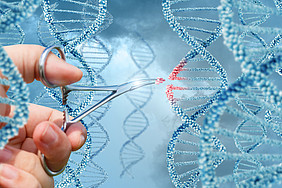Researchers from Würzburg and the USA have succeeded in discovering a new gene scissor. The bacterial immune defense paralyzes infected cells and could advance molecular biological diagnostics.
Bacteria can defend themselves against attackers such as viruses. They have developed their own immune defense strategies for this purpose: Bacterial defense systems such as CRISPR-Cas have various proteins and functions that help bacteria protect themselves against invaders.
The defense is based on a common mechanism: a CRISPR ribonucleic acid (crRNA), serving as a "guide RNA," helps detect regions of a foreign genome, such as the DNA of a virus, for targeted cleavage. The CRISPR-associated (Cas) nuclease directed by a crRNA can cut its target like a pair of scissors: a strategy of nature that humans have harnessed in many technologies.
Now, researchers at the Helmholtz Institute in Würzburg, Germany, in cooperation with Benson Hill, Inc. (Missouri) and Utah State University in the USA, have made an unexpected discovery: They have found a nuclease, called Cas12a2, that represents an entirely new type of CRISPR immune defense. What's special: When Cas12a2 recognizes invasive RNA, the nuclease cleaves it, but can also damage other RNA and DNA in the cell. This kills the cell and thus limits the infection.
Some other CRISPR-Cas systems also worked this way. "However, a CRISPR-based defense mechanism that relies on a single nuclease to recognize the invader and degrade cellular DNA and RNA has never been observed," said Prof. Chase Beisel of the Würzburg-based Helmholtz Institute for RNA-based Infection Research (HIRI). The facility is a site of the Braunschweig Helmholtz Centre for Infection Research in cooperation with the Julius-Maximilians-Universität Würzburg, where Chase Beisel is head of the Department of Synthetic RNA Biology.
Cas12a2 can be used for molecular diagnostics and direct detection of RNA biomarkers, according to a proof-of-concept study.
The results were published in the journal Nature:
Dmytrenko O, Neumann GC, Hallmark T, Keiser DJ, Crowley VM, Vialetto E, Mougiakos I, Wandera KG, Domgaard H, Weber J, Gaudin T, Metcalf J, Gray BN, Begemann MB, Jackson RN, Beisel CL (2023): Cas12a2 elicits abortive infection via RNA-triggered destruction of dsDNA. Nature, www.nature.com/articles/s41586-022-05559-3
Bravo JPK, Hallmark T, Naegle B, Beisel CL, Jackson RN, Taylor DW (2023): Large-scale structural rearrangements unleash indiscriminate nuclease activity by CRISPR-Cas12a2, Nature, www.nature.com/articles/s41586-022-05560-w

